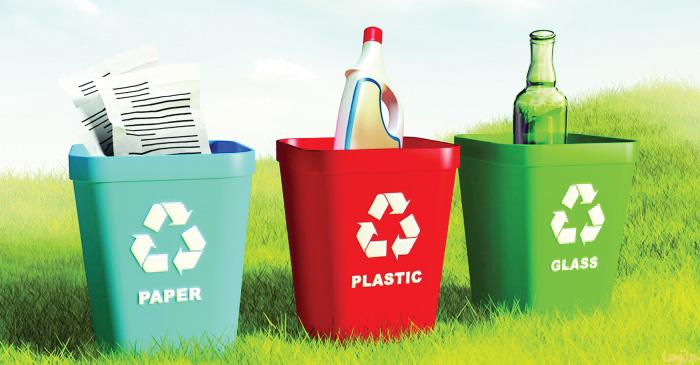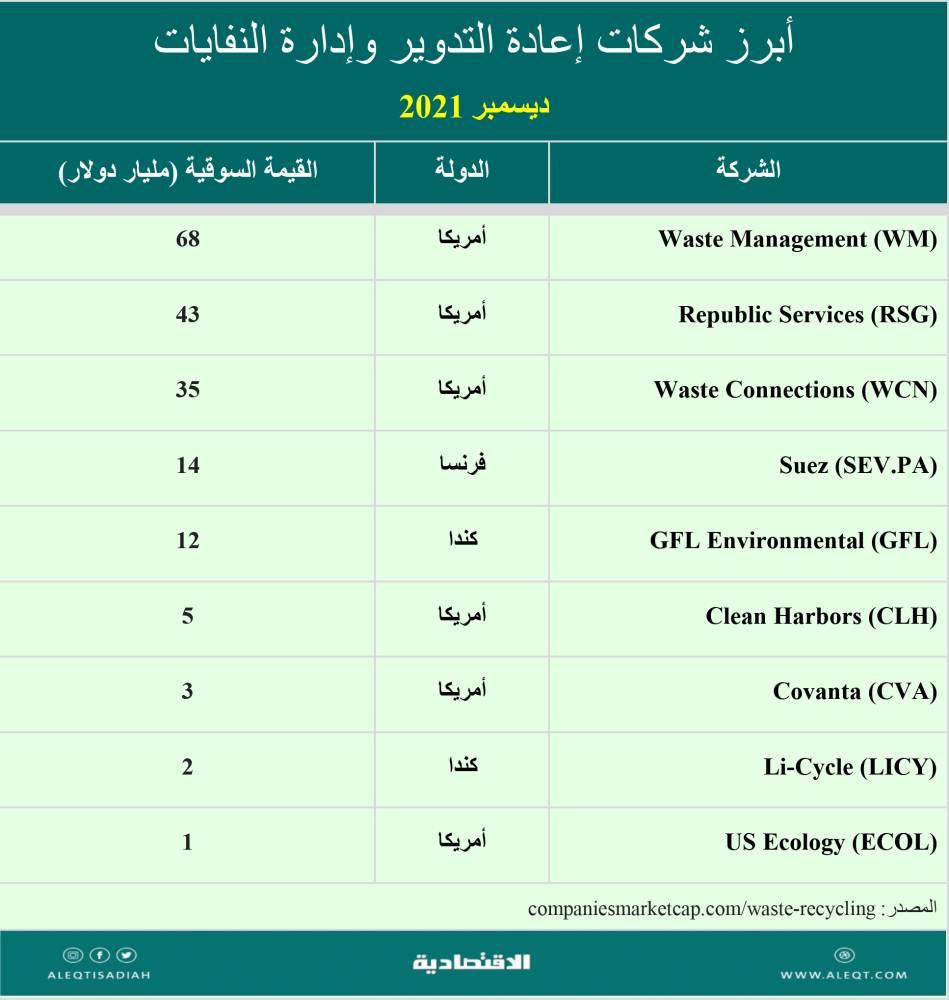The global view of waste has changed in the past years due to the growing interest in taking care of the environment on the one hand, and on the other hand to reduce the costs of waste disposal through recycling and raising awareness of the importance of reuse and innovating the ways to do so. There is also a need to reduce waste costs and make it a source of income for those managing it, including private companies and investors. There is a growing awareness of the importance of controlling waste in all its forms, which we throw daily into landfills and landfills at a great economic and environmental cost. It was established about two years ago here in the Kingdom, and we learn about its goals and activities. Three forms of industrial recycling Recycling is not an idea of the moment nor is it a human invention. Rain after it evaporates from the seas and oceans, we and plants exchange oxygen and carbon dioxide in a way that is beneficial to everyone, etc. Examples related to the food chain between plant, human and animal, all of these are examples of recycling. Recycling is the conversion of unusable waste into New usable materials, and this process comes in three forms: The first form is to repair faults in products to be able to continue to use Its use, such as what happens with used cars that need maintenance and replacement of worn parts in order to be able to run again. The second form of recycling is classification, sorting, and reuse for other purposes, such as using some computer parts from RAM and others in other similar computers, and the third form is re-manufacturing by returning products to their raw form and then using them in other products, such as metal smelting, and the goal is to The end of it is to get the most out of the commodity. Historically, pre-industrial scrap metal was recycled in Europe through smelting and remodeling, while bricks were made from wood ash, and according to Handbook Energy, shredded paper was sold in Britain in the beginnings The first millennium, which is perhaps the first industrial recycling of paper! The stages of recycling According to the US Environmental Protection Agency, the recycling process consists of three stages, the first stage is the process of collection and treatment, in which the waste is collected and then the recyclable materials are sent to a specialized facility for sorting, cleaning, processing and transformation into raw materials that can be used in the second stage, which is the manufacturing stage. In the second stage, usable products are manufactured such as newspapers, soft drink bottles, carpets, etc., and in the last stage, the role comes to the consumer who closes the cycle by purchasing products made from recycled materials, thus reducing the cost for him and contributing to protecting the environment and depleting natural resources. The environmental benefits of recycling are among the The environmental benefits that come from recycling, reducing carbon emissions and thus reducing global warming, compared to obtaining raw materials from the ground that requires more energy for extraction. Non-recycling leads to an increase in air pollution as a result of incineration of waste such as paper and plastic, and also resulting from non-recycling of waste that results in toxic substances leaking into the soil or water is buried. Finally, perhaps the most important benefits of recycling are the preservation of natural resources and environmental sustainability. In fact, it serves as an important alternative to the reserves of raw materials that are depleted, or those that the country may not have in the first place as a natural resource, or that the country does not have the necessary infrastructure to extract them. Among the economic advantages of recycling also provide job opportunities and support industry and investment as a whole, The recycling industry provides ten times more jobs than landfills and incinerators. According to the US Environmental Protection Agency, the recycling and reuse industry provides 681,000 jobs annually in the United States, while the number of global jobs related to it is estimated, according to "Eco Cycle", a non-profit recycling company, between 15 to 20 million jobs around The world. What are the disadvantages of recycling? There are some criticisms of recycling, including that the cost of collecting and transporting waste may sometimes exceed the energy costs saved in the production process of raw materials, for example, although paper recycling saves 50 percent of the water used In manufacturing, one ton of paper reused saves about 17 trees, but the process also requires 40 percent more energy compared to obtaining raw materials from wood! The situation gets worse with the decline in the prices of basic materials for manufacturing, for example, the cost of sand is low compared to recycling glass, or in the field of oil, where its prices are sometimes much lower than recycling plastic. So here comes the aspect of innovation and the use of advanced technologies to reduce the cost of recycling. The number of times of recycling has its limits. Despite the importance of recycling, every material has a different nature from the other, so when some of them are re-manufactured several times they perish and are not usable as they should, or they are not be of first quality. According to the website of the company "Earth 911", which specializes in sustainability, plastic is recycled between one or two times at most, and even with recycling, it often does not return to the original commodity shape and characteristics that it was, but rather is recycled into the so-called plastic wood or synthetic fibers. For weaving and spinning. Also, paper is one of the materials with limited recycling, it is recycled from five to seven times, and then the fibers that make it up, where the paper loses every time it is recycled part of its quality compared to paper made for the first time. On the other hand, there are materials such as metal or glass that can be recycled several times, and each time results in the original raw material to a large extent. Finally, one of the criticisms of recycling is that it leads to the loss of a number of traditional jobs. Missing in production, logging, mining, and others. Difficulties facing recycling One of the difficulties facing recycling is what was mentioned in the book Remaking the Way We Make Things, which is that most products were not qualified from the beginning to recycling, they were not designed from the beginning in this way, Therefore, it is suggested that each component in any product should have a complete closed cycle and return to the ecosystem either through biodegradation or recycling. Despite these hopes, complete recycling is impossible, according to researcher Michael H. Heusman in a paper titled “The Limits of Technological Solutions to Sustainable Development,” in which the researcher believes that what the recycling process does is merely delay the depletion of non-renewable stocks and thus gain More time to move to real sustainability in which the economy depends on renewable resources. Also among the difficulties facing recycling, there is the problem of overlapping many materials with each other, both because of the nature of their manufacture, such as juice boxes whose packaging consists of plastic, cardboard and aluminum foil Therefore, it requires a lot of separation processes, or as a result of humans mixing different wastes with each other, which negatively affects two main factors: the first is the high cost due to excessive energy and the multiplicity of stages, and the second is the dispersal and loss of a lot of materials that might have been used. One of the solutions to this problem, according to the newspaper "The Economist", is separating the waste from the beginning of its collection, and although this contributes to reducing the cost, the cost of the mixed materials remains high compared to the revenue from their sale. According to the American Waste and Recycling Association, the value of processing mixed materials in the 1990s was $50, with only $30 in revenue from their sale. This is shown in the figures of the United Nations Environment Program report, which indicates that the recycling of plastic represents only 9 percent of what is produced, and it is expected that the proportion of the plastics industry from the total oil industry by 2050 will reach 20 percent. 12 percent of plastic ends up in burning and 79 percent in burial or dumping in the environment, where rivers and oceans carry eight million tons of it every year, which means, according to some estimates that are not without exaggeration, that the oceans contain more plastic than fish by 2050, as it is estimated that the materials Plastic kills about one million marine creatures annually, according to Georgia State University. Although recycling a single plastic bottle may provide enough energy to run a laptop for 2.5 hours, according to the US Environmental Protection Agency, recycling it depends on how clean the plastic is, many of which are not recyclable, due to the Some plastic waste contains dangerous chemicals and medical materials, such as medical needles, solutions, and others. Paper recycling Despite the high rates of paper and cardboard waste globally, which amount to 20 percent of total waste, it is one of the highest rates of recycling than any other waste, according to data from the Center. Statista" for data and statistics, as the global market for paper recycling is estimated at $46 billion this year, and is expected to grow to $56 billion in 2025, according to "Business Wire", compared to the global market for the paper industry of $349 billion. In 2020, the continent of Europe is the best in the world in paper recycling by 72 percent, followed by North America with 66 percent, where paper fibers were reused in Europe 3.8 times during 2020, compared to 2.4 times globally, according to the association European Cepi representing the industry. Recycling one ton of paper saves energy equivalent to 1.2 thousand liters of gasoline, according to the US Environmental Protection Agency, and recycling newspapers in the United States alone saves a quarter of a billion trees annually, according to Georgia State University. It aims to organize waste management and stimulate investment in it on the basis of what is known as the circular economy, and the center seeks to do this through innovation and the adoption of best practices and modern technologies. The center has goals to dispose of waste in landfills through recycling, raise awareness among people to reduce waste production and encourage reuse and recycling. The center is interested in the investment aspect by encouraging investment in waste management systems of all kinds, and adopting different models for financing waste management to achieve the financial sustainability of the center. The center has ambitious goals to control waste by 2035, including reducing the need for landfills by 82 percent and raising the recycling rate to 42 percent of waste, generating 77,000 jobs, and in the end, the Center expects that the contribution of waste management to the GDP will reach 120 billion riyals. The center has already started its operations through a number of agreements and partnerships, one of which is, for example, with the international soft drink company "PepsiCo" with the aim of eliminating plastic waste through innovative solutions in the fields of packaging, one of which is the production of solar-powered containers, which The global waste marketAccording to the World Bank, high-income countries generate more than a third of the world's waste amounting to more than two billion tons of solid waste annually, of which 33 percent are not managed in an environmentally safe manner. The volume of waste is expected to reach 3.4 billion tons by 2050. The market value of waste services management globally, according to market research and consultancy firm "Alid Market Research", has reached $1.6 trillion in 2020, and is expected to reach $2.5 trillion by 2030. The European Union, according to the International Waste Federation, has the largest number of recycling plants with a total of 512 factories, which is about twice the number of factories in the United States (121 factories), Japan (98 factories) and China (55 factories). According to the World Bank, global waste consists of 44 percent are food, 17 percent are paper and cardboard, 12 percent are plastic, and 27 percent are other materials, and these wastes are disposed of at 33 percent randomly that does not protect the environment, 25 percent are disposed of by landfill, and 14 percent are recycled , 11 percent is incinerated, and 8 percent ends up in landfills. At the Arab level, Arab countries waste about 122 billion dollars as a result of not recycling waste, and at the level of the Kingdom only 10 percent of waste is recycled, which is estimated in size, according to studies by the Fund investment Public waste, by about 50 million tons, and it is targeted that the Kingdom will become more sustainable by 2035 by recycling 82 percent of total solid waste and 47 percent of construction waste. Shares of companies working in the field of recycling, like any other trade, the waste market is large and there are global purchases between Countries, and not only at the local level, where waste is a valuable raw resource and an essential substitute for the extraction and production of raw materials that will not cover global consumption. The United States leads the waste export market by about 50 percent, with a value of 14 billion dollars in 2019, according to the “OEC” platform specialized in data collection and distribution, while India became a leader in importing waste with a total of 8.4 billion dollars, followed by China with 8.2 One billion dollars, which banned the import of plastic materials in the same year in comparison after it was the largest global destination for its import, and this is evident in its high tariffs compared to metals and paper, because many countries mainly face difficulties in getting rid of the plastic consumed within their territories. Conclusion Recycling is not the option It is better, compared to reducing consumption in the first place, but it offers effective solutions to many of the existing problems, including problems that threaten the future of humankind on Earth, whether through the depletion of available resources or the health damages of waste. Here in the Kingdom, there is great interest in the field of waste management, which resulted in the establishment of the National Center for Waste, which will raise awareness of this important issue and urge rationalization of consumption in general and the adoption of a culture of recycling and reuse. One of the leading American companies in this field, particularly in the field For proper waste disposal, there is waste management company WM, which has sales for the last 12 months of $17 billion and net profit of $1.7 billion.
Share it











